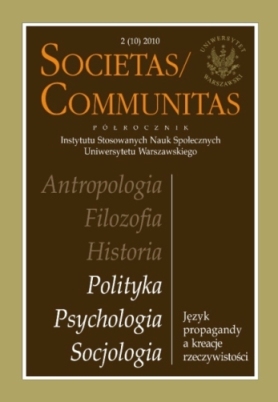Ramy i ramowanie w debatach przedwyborczych - szkic z socjologii form perswazyjnych
Frames and Framing in Election Debates: Sociology of Persuasion Forms. An Essay.
Author(s): Tomasz OlczykSubject(s): Social Sciences
Published by: Instytut Stosowanych Nauk Społecznych Uniwersytetu Warszawskiego
Summary/Abstract: The aim of the article is to describe the frames – patterns of selection, amplification and structuralization – used by the leaders of the three biggest political parties in the three de-bates which took place before the 2007 Polish parliamentary elections. The frames were used as tools to form a persuasive image of reality for the voters. The article presents the general premises of frame theory and suggests the central categories for the processes of framing in persuasive political messages. The subsequent part shows a narrative-rhetorical model of creating images of reality in political persuasion. The model is then compared to the patterns visible in the statements of the participants of the debates. The analysis shows that in their statements Donald Tusk and Jarosław Kaczyński used “clean,” non-alternative patterns of constructing reality, with a clear “us-them” division, and explicitly pointed out those responsible for both positive and negative “states of the world” (Arcadias and Dystopias). Aleksander Kwaśniewski formulated a less non-alternative and explicit image. The common usage of modeled frame patterns in mes-sages both persuasive (such as debates and political advertisement on television) and in-formative, as a result creates two opposing types of “virtual audiences”. It is probable that the common usage of frame patterns will remain in a self-reinforcing relation with the growing polarization of the political scene.
Journal: Societas/Communitas
- Issue Year: 2010
- Issue No: 10 (2)
- Page Range: 213-232
- Page Count: 19
- Language: Polish

